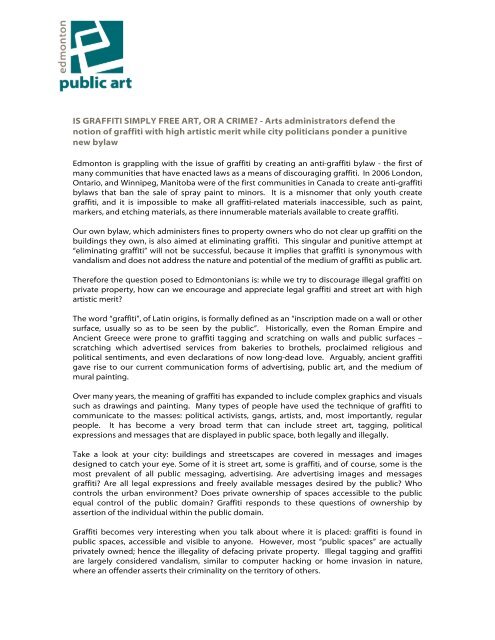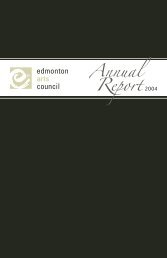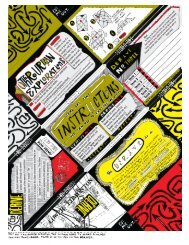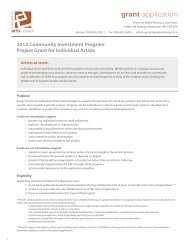IS GRAFFITI SIMPLY FREE ART - Public Art - Edmonton Arts Council
IS GRAFFITI SIMPLY FREE ART - Public Art - Edmonton Arts Council
IS GRAFFITI SIMPLY FREE ART - Public Art - Edmonton Arts Council
You also want an ePaper? Increase the reach of your titles
YUMPU automatically turns print PDFs into web optimized ePapers that Google loves.
<strong>IS</strong> <strong>GRAFFITI</strong> <strong>SIMPLY</strong> <strong>FREE</strong> <strong>ART</strong>, OR A CRIME - <strong>Art</strong>s administrators defend the<br />
notion of graffiti with high artistic merit while city politicians ponder a punitive<br />
new bylaw<br />
<br />
<strong>Edmonton</strong> is grappling with the issue of graffiti by creating an anti-graffiti bylaw - the first of<br />
many communities that have enacted laws as a means of discouraging graffiti. In 2006 London,<br />
Ontario, and Winnipeg, Manitoba were of the first communities in Canada to create anti-graffiti<br />
bylaws that ban the sale of spray paint to minors. It is a misnomer that only youth create<br />
graffiti, and it is impossible to make all graffiti-related materials inaccessible, such as paint,<br />
markers, and etching materials, as there innumerable materials available to create graffiti.<br />
Our own bylaw, which administers fines to property owners who do not clear up graffiti on the<br />
buildings they own, is also aimed at eliminating graffiti. This singular and punitive attempt at<br />
“eliminating graffiti” will not be successful, because it implies that graffiti is synonymous with<br />
vandalism and does not address the nature and potential of the medium of graffiti as public art.<br />
Therefore the question posed to <strong>Edmonton</strong>ians is: while we try to discourage illegal graffiti on<br />
private property, how can we encourage and appreciate legal graffiti and street art with high<br />
artistic merit<br />
The word “graffiti”, of Latin origins, is formally defined as an “inscription made on a wall or other<br />
surface, usually so as to be seen by the public”. Historically, even the Roman Empire and<br />
Ancient Greece were prone to graffiti tagging and scratching on walls and public surfaces –<br />
scratching which advertised services from bakeries to brothels, proclaimed religious and<br />
political sentiments, and even declarations of now long-dead love. Arguably, ancient graffiti<br />
gave rise to our current communication forms of advertising, public art, and the medium of<br />
mural painting.<br />
Over many years, the meaning of graffiti has expanded to include complex graphics and visuals<br />
such as drawings and painting. Many types of people have used the technique of graffiti to<br />
communicate to the masses: political activists, gangs, artists, and, most importantly, regular<br />
people. It has become a very broad term that can include street art, tagging, political<br />
expressions and messages that are displayed in public space, both legally and illegally.<br />
Take a look at your city: buildings and streetscapes are covered in messages and images<br />
designed to catch your eye. Some of it is street art, some is graffiti, and of course, some is the<br />
most prevalent of all public messaging, advertising. Are advertising images and messages<br />
graffiti Are all legal expressions and freely available messages desired by the public Who<br />
controls the urban environment Does private ownership of spaces accessible to the public<br />
equal control of the public domain Graffiti responds to these questions of ownership by<br />
assertion of the individual within the public domain.<br />
Graffiti becomes very interesting when you talk about where it is placed: graffiti is found in<br />
public spaces, accessible and visible to anyone. However, most “public spaces” are actually<br />
privately owned; hence the illegality of defacing private property. Illegal tagging and graffiti<br />
are largely considered vandalism, similar to computer hacking or home invasion in nature,<br />
where an offender asserts their criminality on the territory of others.
Part of the subversive reputation of graffiti culture is the idea that you can claim your city. This<br />
concept directly relates to modern art movements that advocate that the city can be viewed as<br />
an outdoor gallery. And that art should be for everyone, and should not be restrained to the<br />
context and regulations of a traditional white-cube art gallery exhibition space, which is usually<br />
considered to be exclusive in terms of which artists are represented and how the artwork is<br />
presented.<br />
In this context, the medium of graffiti provides a creative expression that initially managed to<br />
bypass the bureaucratic systems of the art world. Banksy, an anonymous British street artist,<br />
has gained notoriety through his graffiti interventions of seditious spray painted and stenciled<br />
public artworks, which are now sold by Sotheby’s auction house in London for over $500,000<br />
CAD. The popularity of his works reflect both the prevalence and range of graffiti in<br />
mainstream culture and have elevated Banksy to the status of an icon, as evident in his<br />
nomination as the Greatest Living Briton 2007 in the award category of the <strong>Art</strong>s.<br />
One example of an initiative to promote positive graffiti relations is for a municipality to<br />
designate areas as legal graffiti walls. Legal graffiti walls are really just open source murals,<br />
where artists have permission to create street art and graffiti-style public artworks, which are<br />
often complex in technique and composition. Graffiti can have a significant artistic value, and<br />
does indeed have a legitimate place throughout art history. Renowned artists, including Keith<br />
Haring and Jean-Michel Basquiat, have elevated the use of graffiti iconography and practice to<br />
that of avant-garde or high art. Recognizing and encouraging the aesthetic complexity and<br />
artistic merit in graffiti is important in discouraging graffiti which is created solely for the<br />
purpose of marking territory – essentially, quality versus quantity. <strong>Edmonton</strong> currently has one<br />
designated legal graffiti site, where the LRT emerges from the underground between Churchill<br />
Station and Stadium. A second commonly known site where graffiti is tolerated but unofficially<br />
sanctioned is the109th Street pedestrian corridor near the Legislature grounds.<br />
Street art and legal graffiti murals are an important example of how public art can transform a<br />
plain grey cement wall, providing free art for everyone. Creating bylaws to limit the sale of<br />
spray paint or enforcing property owners to clean up defaced buildings will not eradicate<br />
graffiti because it is a demonstrated medium of communication that has been used for<br />
centuries. Anti-graffiti bylaws created by the municipality should be accompanied with a plan<br />
to significantly increase the number of legal and sanctioned graffiti areas as well as an<br />
education strategy that promotes the development of graffiti with high artistic merit for graffiti<br />
artists, and encourages the public to appreciate the aesthetic elements and incredible skill<br />
evident in high quality graffiti.<br />
Encouraging legal spaces for street art is an essential strategy as a proactive means to<br />
discouraging illegal vandalism; it allows spaces for creative and healthy public expression,<br />
creating interesting and dynamic cultural cities with images and artworks that beautify the city<br />
environment, and challenge and inspire its inhabitants.<br />
Kristy Trinier<br />
<strong>Public</strong> <strong>Art</strong> Director<br />
<strong>Edmonton</strong> <strong>Art</strong>s <strong>Council</strong><br />
September 2007








